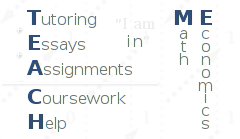Chapter 0: EG.3 Solution
Working problems is a crucial part of learning mathematics. No one can learn topology merely by poring over the definitions, theorems, and examples that are worked out in the text. One must work part of it out for oneself. To provide that opportunity is the purpose of the exercises.
James R. Munkres
Let
be the free group with two generators
and
. Start at time 0 with the unit element 1, the empty word. At each second multiply the current word on the right by one of the four elements
,
,
,
, choosing each with probability
(independently of previous choices). The choices
at times 1 to 9 will produce the reduced word
of length 3 at time 9. Prove that the probability that the reduced word 1 ever occurs at a positive time is 1/3, and explain why it is intuitively clear that (almost surely)
The length of the reduced word can be thought of as Markov chain
Let
be the probability of ever returning to state
. Then, since after the first step the length is
,
must satisfy
or
Let
(
) be the probability of reaching state
from state
in at most
(in any number of) steps. Let
(
) be the corresponding events. Then, as it is easy to see,
, and, hence,
. So, if we show that
for all
, then we will show that
. For this, suppose that
,
, solve the system
Then,
for all
. Indeed,
and
It remains to note that
indeed solves the system.
Intuitively the last statement of the problem is clear because at each step (unless when the current word is empty, which happens only finitely often with probability
) the length is increased by
with probability
, and decreased by
with probability
, so on average it increases by
. A bit more formally, let
be the word length after
steps. Consider i.i.d.
where
,
. Let
. Then, we can interpret
. By the strong LLN,
. Further, if
, then
and
. Therefore, with probability
, only a finite number of
is positive (intuitively, we return to
only a finite number of times with probability
), and, hence,
with probability
.
